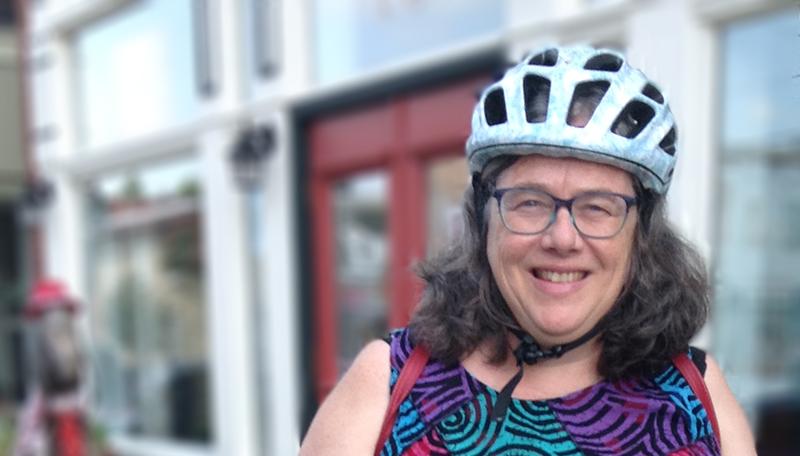“We did a lot of die-ins,” Vankleek Hill resident Pat Deacon says offhandedly. “You know, we’d go out in the middle of traffic, drop our bikes and just lie down in the road.”
Rest assured, this is just as sensational in context. Deacon is speaking of her time with Le Monde à Bicyclette, a cycling activist group that effected major change to the transport system in Montreal from the 70s through the 90s.
Deacon herself has had a long and fruitful relationship with cycling; in fact, she’s never driven.
“I basically spent my adolescence riding my bicycle to the nearby villages, the lakes,” she begins, settling into a familiar narrative.
“And then, when I moved to Montreal, which is the first city I lived in, I rode everywhere.”
It was during this time that Deacon became acquainted with cycling activism. “One day I was in class at McGill and, in the middle of the lecture, this man stood up in the audience. His t-shirt on the back had a statistic around how many people were killed in car accidents, as compared to how many people are killed in wars. And the professor, he stopped what he was talking about and he pointed to the man and said, ‘There goes an intelligent man! Follow him, find out what he’s all about.’ And so I did. It turned out his name was Bob Silverman, and he had started a group called Le Monde à Bicyclette. This was back in the early 70s. So I immediately joined the group and got very involved, and for the next few years I was a cycling activist.”
“Cycling in Montreal was abysmal. It was scary, it was dangerous – I mean, there were no cycling lanes.” She shakes her head.
“One thing we did, we got up in the middle of one night with some neon paint, and we painted a line on one East-West street and one North-South street, and drew symbols within the line… And then we ticketed all the cars there for being in a cycling lane. Then, in the morning, we called a press conference. It was great.” Deacon chuckles at the memory.
“But our main push was for public transit, and for bicycles on public transit, those were our main points. And the other was cycling lanes, so that cycling became a viable transportation option for people who lived in Montreal. Which it was not, at that point. It’s a very bike-friendly city now. And it was Le Monde à Bicyclette, the work that we did as activists, that years later meant that there were cycling lanes and bicycles on the metro. So it was quite exciting for me, years later, to find out how things had changed in Montreal, and they were exactly the sort of things that we had been planning for in those days.”
After such an introduction to the world of cycling, it’s no wonder that she continued the lifestyle later on. “I really didn’t want to drive, you know, I didn’t have a license when I left home, and living in Montreal I felt no need to have one. Plus, I had all this other perspective on things, that cars were actually a bad thing. So [my husband] Derek and I lived for a long time without cars as much as possible. When we lived in Toronto, we used trailers for our kids – I would ride from one end of the city to the other with kids in a carrier, right through downtown. It was just the way we did things.”
Bringing it home
“Here, I feel like I’m a bit of an anomaly,” Deacon continues, amused. “I mean, people refer to me as “the one that rides her bicycle!” I’m seeing more this year, though, which is nice. One very exciting day, I was parking my bike outside the post office and someone else had parked their bike there too, and I thought ‘wow, two bicycles, this is really good!” She trails off with a laugh.
Living car-free in Vankleek Hill can be a challenge; the steep hills, for one, and the danger of cycling on country roads or highways. But according to Deacon, there are many things that the town could be doing to reduce the harm caused by motor vehicles.
“There are Greyhound buses that come through here and don’t stop,” she says disbelievingly. “That would be an option, to actually set up a bus stop. And I think that having trains from here would fundamentally change the village in a good way. People could commute to work! It would be a viable option for people to have a life here and still work in the city. And people still do it, but it’s very unpleasant and very hard for them now.”
“I don’t think people should ditch their cars. But we really should think about how we use cars, and why,” she explains. “I take the car to the grocery store with my husband, I ride out to Zumba with some of the other people there – for me, that’s a social thing. But I think there’s still an attitude here that bicycles are only used by children. There’s a social stigma against bicycles, while it’s perfectly acceptable to drive three doors down and jump out with the car running.”
“So my message is: dust off the bike and use it. When you’re on a bicycle you notice things, just as you do if you’re walking; you have a completely different perspective on everything. Part of it is that it’s friendlier; there’s interaction with people in the street, people in their gardens, the odd other person who happens to be on their bicycle. It’s a more open way of travelling, I think, and one where you observe more.”


